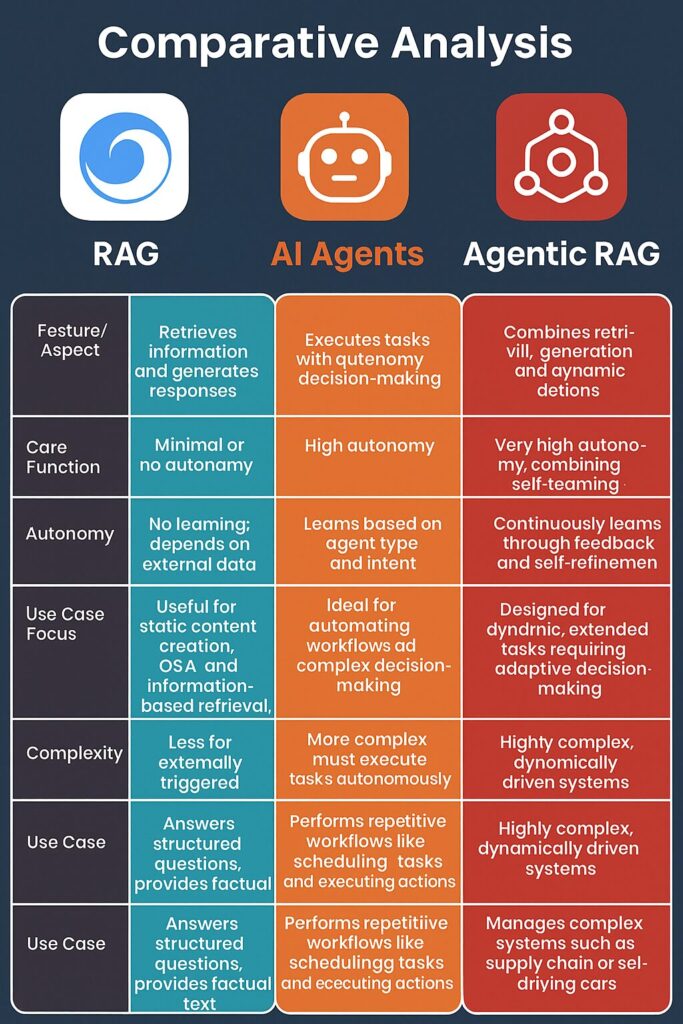Artificial Intelligence (AI) is changing fast. If you are interested in AI, you’ve probably heard about RAG, AI Agents, and Agentic RAG. These are important tools in the world of modern AI. But what do they mean? How are they different? And which one should you use?
This article will explain everything in easy language. Whether you’re a beginner or just curious, this guide will help you understand the differences, uses, and benefits of RAG, AI Agents, and Agentic RAG.
🔍 What is RAG (Retrieval-Augmented Generation)?
RAG stands for Retrieval-Augmented Generation. It is a simple type of AI model that uses information from external sources to answer questions or create content.
✅ Key Features of RAG:
- Retrieves information and generates responses.
- Has minimal or no autonomy – it needs to be told what to do.
- Does not learn by itself – it uses pre-trained models.
- Best for static content creation like FAQs, blogs, and Q&A bots.
🧠 Use Cases:
- Creating structured knowledge bases.
- Providing factual and straightforward answers.
- Educational tools and content engines.
🤖 What are AI Agents?
AI Agents are smarter and more advanced than RAG. These agents can make decisions, plan actions, and work on tasks without help.
✅ Key Features of AI Agents:
- Can execute tasks autonomously.
- Have high autonomy and adapt to tasks easily.
- Learn based on agent type and what input they receive.
- Great for automation of workflows.
🧠 Use Cases:
- Automating business tasks like scheduling and data entry.
- Reducing human intervention in repetitive jobs.
- Helping teams make faster decisions.
🚀 What is Agentic RAG?
Agentic RAG is the most advanced type among the three. It combines the best of both RAG and AI Agents. It can retrieve data, generate content, and act on its own with dynamic decision-making.
✅ Key Features of Agentic RAG:
- Very high autonomy with self-learning and self-improvement.
- Continuously learns from feedback and refines its behavior.
- Designed for complex tasks that change in real-time.
- Involves multiple steps and decisions without human help.
🧠 Use Cases:
- Managing supply chain systems.
- Running self-driving cars.
- Handling complex AI operations in real-time environments.
⚖️ Comparison Table Summary:
| Feature | RAG | AI Agents | Agentic RAG |
|---|---|---|---|
| Core Function | Info retrieval & response | Autonomous task execution | Retrieval + Generation + Dynamic Actions |
| Autonomy | Minimal | High | Very High + Self-learning |
| Learning Ability | No self-learning | Learns from input & intent | Learns continuously from feedback |
| Use Case Focus | Static content, Q&A | Workflows, decision automation | Complex, changing tasks (e.g., supply chain) |
| Complexity | Simple to moderate | Complex | Very complex, multi-step systems |
| Best Use Case | FAQs, chatbots, knowledge | Task automation, virtual assistants | AI system managers, real-time AI processes |
🏆 Which One Should You Choose?
- Use RAG if you want to answer simple questions or create factual content.
- Use AI Agents if you want to automate daily tasks or reduce manual work.
- Use Agentic RAG if you need smart systems that work on their own in complex environments.

✅ Advantages & ❌ Disadvantages of RAG (Retrieval-Augmented Generation)
✅ Advantages:
- Simple and Easy to Use
Great for quick integration and requires minimal setup. - Accurate for Factual Information
Pulls real-time or up-to-date data from trusted sources. - Low Computational Cost
Doesn’t need much processing power compared to agents. - Good for Knowledge Management
Excellent at answering FAQs, documentation, and generating reports.
❌ Disadvantages:
- Limited Autonomy
It only works when prompted and cannot act on its own. - No Learning Ability
Doesn’t improve or adapt unless manually updated. - Not Suitable for Dynamic Tasks
Can’t handle tasks that require decisions or complex planning.
✅ Advantages & ❌ Disadvantages of AI Agents
✅ Advantages:
- High Autonomy
Can complete tasks with little or no human input. - Flexible & Adaptable
Works across many domains like scheduling, customer support, etc. - Learning Capabilities
Learns and adapts based on inputs and goals. - Improves Workflow Efficiency
Reduces manual labor and saves time.
❌ Disadvantages:
- Higher Complexity
Needs proper training, logic, and sometimes supervision. - Can Be Costly
More resources and time needed to set up and maintain. - May Struggle with Unclear Goals
Not as efficient without clear task definitions.
✅ Advantages & ❌ Disadvantages of Agentic RAG
✅ Advantages:
- Very High Autonomy
Can plan, decide, and act on its own without help. - Self-Learning and Self-Improving
Continuously refines itself using feedback. - Ideal for Complex & Dynamic Tasks
Perfect for real-time systems like supply chain or robotics. - Combines Best of Both Worlds
Merges RAG’s knowledge capabilities with AI Agents’ decision-making.
❌ Disadvantages:
- Highly Complex
Requires expert-level setup, architecture, and training. - Resource Intensive
Needs powerful hardware and infrastructure. - Harder to Monitor
Full autonomy can sometimes be unpredictable if not designed carefully. - Not Ideal for Small Tasks
Overkill for simple Q&A or content generation tasks.
🏁 Conclusion
Each of these AI types serves a different purpose:
- Choose RAG if you want a quick, reliable tool for info retrieval and content creation.
- Choose AI Agents if you’re ready to automate and streamline repetitive workflows.
- Choose Agentic RAG if you’re building advanced AI systems that need to think, learn, and act on their own.
By knowing the pros and cons, you can better align your goals with the right AI strategy.
✍️ Final Thoughts
AI is becoming smarter every day. RAG, AI Agents, and Agentic RAG are at the center of this revolution. Whether you’re a student, business owner, or tech enthusiast, knowing how these tools work can help you use AI more effectively.
Start with RAG, explore AI Agents, and step into the future with Agentic RAG.
- LLM Prompts That Actually Work for Summarizing Long Documents
- Generate High-Converting Product Descriptions with These LLM Prompts
- Unleash Your Creativity: Mastering LLM Prompts for Story Writing
- Crafting Compelling Emails with AI: Effective LLM Prompt Strategies
- Boost Your Social Media: Proven LLM Prompts for High-Impact Content



